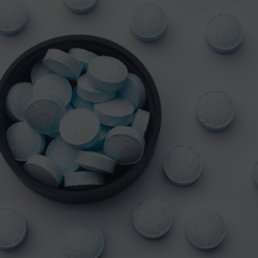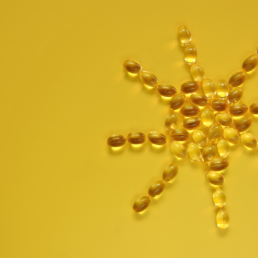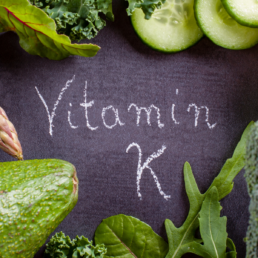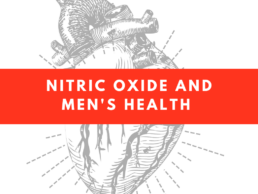Unleash the Power of Oral Chelation Supplements: Understanding Heavy Metal Detoxification
In our increasingly polluted environment, it’s essential to explore innovative strategies to maintain our bodies in a state free from damaging toxins and impurities. Global pollution and ecological challenges have led to a surge of interest in oral chelation supplements. Particularly popular are those targeting heavy metal detoxification. Contaminated food, beverages, manufacturing processes, and pesticides can all contribute to an unwanted toxic burden.
It is essential to understand the methods for removing toxins from our bodies and the potential damage they can cause.
Prominent in the field of Chelation is Chelanox by Bionox®. Chelanox is a potent blend of botanicals engineered to counter the harmful impacts of heavy metals in our systems. We’ve meticulously researched each ingredient to curate the most effective formulation. Our goal today is to enlighten you about the intricacies of Chelation and the rationale behind our ingredient selection.
Exploring Oral Chelation
Oral chelation represents a health or dietary intervention that leverages certain compounds to purge the body of detrimental toxins, mainly heavy metals.
Known as chelating agents, these elements bind with the toxins and heavy metals inside the body. This helps the body detox by creating a stable chelate compound. The body then safely removes this compound through urine or feces. Initially used to fight against heavy metal toxicity, the application of this therapy has expanded over time.
The introduction of products like Chelanox has expanded its scope to encompass preventative health and overall wellness.
Oral chelation could play a pivotal role in protecting and elevating your health:
- Diminishing Toxic Burden – The main advantage of oral chelation is the diminution of toxic burden, primarily heavy metals like arsenic, lead, and mercury.
- Maintaining Heart Health – Research indicates that chelation therapy could decrease the accumulation of specific types of plaque in arteries, thereby facilitating optimal cardiovascular well being.
- Preserving Kidney Health: By alleviating the load of toxins and heavy metals, oral chelation products could help maintain the health of your kidneys.
- Preserving Neurological Function – Chelation therapy could help maintain neurological function by expelling heavy metals from your body.
- Immune System – Chelation therapy can boost immune system health and general vitality by lessening the total toxic load on the body.
- Boosting Vitality Levels – Chelation supplement users often report a surge in vitality levels. This is likely due to reduced systemic stress caused by toxins and heavy metals. Increased vitality leads to an overall better feeling and increased activity, which is always beneficial!
- Gut Health – Chelation therapy could bolster gut health by expelling toxins from the body.
- Enhancing Skin Health – Chelation therapy might boost skin health by facilitating the expulsion of toxins, leading to a cleaner, more glowing complexion.
- Maximizing Nutrient Uptake – Reduced toxic interference may allow the body to absorb and utilize essential nutrients from your diet more effectively.
- Maintaining Liver Health – The liver plays a key role in detoxification within the body. Chelation could foster healthier liver function by assisting the body in toxin removal.

Reducing toxic load
Let’s examine the key ingredients in our Chelanox product to understand their functions:
- EDTA Calcium Disodium. A study in the Journal of Advancement in Medicine found that oral intake of EDTA can be beneficial for reducing lead toxicity.1
- Chlorella Algae. A recent study published in Nutrition Research and Practice concluded that chlorella could decrease the amount of dioxin in breast milk and in the body generally. 2
- Modified Citrus Pectin. MCP is a type of pectin that has been altered to be more easily absorbed by the digestive tract. A study in Phytotherapy Research indicated that MCP can help reduce lead levels in the body. 3
- Cilantro Leaf Extract. A study that was published in the Journal of Traditional Chinese Medicine suggests that cilantro can expedite the body’s excretion of lead and mercury. 4
- Shilajit. Shilajit is rich in fulvic and humic acids, which may possess chelating properties, according to a study in the Journal of Ethnopharmacology. 5
- Zeolite. Zeolites are volcanic minerals that can act like magnets for toxins. Research has shown that zeolite clinoptilolite can trap and remove harmful toxins, including heavy metals, from the body. 6
- N-Acetyl Cysteine. Is known to enhance the production of glutathione. 7
- Alpha Lipoic Acid. ALA is a potent antioxidant that can bind with toxic free radicals and help remove them from the body. A study in Free Radical Biology & Medicine found that ALA can help the body detoxify from heavy metals. 8
- Uva Ursi Leaf and Milk Thistle Seed . These ingredients, traditionally used in herbal medicine, are included for their diuretic and liver-supporting properties, respectively, thus aiding in the detoxification process. 9, 10
How does oral chelation enhance heart health?
Chelation therapy has been studied for its potential benefits in treating cardiovascular disease, mainly by addressing atherosclerosis. Atherosclerosis is a condition characterized by the buildup of plaques in the arteries.
These plaques, primarily comprised of cholesterol, fat, and calcium, can restrict blood flow and potentially lead to severe cardiovascular events like heart attack or stroke.
While the mechanism isn’t entirely understood, some theories suggest that the calcium-disodium form of EDTA could bind with the calcium in these plaques, thus helping to reduce their size and improve blood flow. For this reason, we use this form of EDTA in Chelanox.
Trial to Assess Chelation Therapy
One of the most significant studies in this area is the Trial to Assess Chelation Therapy (TACT). This doubleblind, placebo controlled study, sponsored by the National Institutes of Health, was designed to determine the safety and effectiveness of EDTA chelation therapy in individuals with coronary artery disease.
The results, published in the Journal of the American Medical Association (JAMA) 11, showed that a course of 40 infusions of a high-dose multivitamin and disodium EDTA chelation solution modestly reduced the risk of adverse cardiovascular outcomes, including recurrent heart attacks, stroke, and death, among study participants who had previously suffered a heart attack.
Additionally, a follow-up study, TACT2 12, is currently underway to further explore the potential benefits of EDTA chelation therapy for post-heart attack patients with diabetes, as this subgroup seemed to benefit the most in the initial TACT study.
Intravenous EDTA
It’s important to note that oral chelation may not offer the same level of cardiovascular benefits as intravenous EDTA. This is because of the lower absorption rate of oral EDTA. At Bionox, we use acid resistant capsules in our chelation product to ensure better absorption of EDTA calcium. This occurs because the capsules allow it to bypass the stomach and enter the intestines for greater potential uptake. You should not use EDTA in capsule form unless it is in acid resistant capsules. Only EDTA Calcium Disodium should be used for maximum effect and safety.
Binding of Chelating Agents to Toxins
When we say chelating agents bind to toxins, we refer to a chemical process where the chelating agent forms a complex with the toxin. Chelating agents have multiple binding sites. These sites allow them to form stable complexes with metal ions. In other words, they connect with and bind to them. This ability to bind is based on the atomic structure of the chelating agent and the toxin.
Take, for example, EDTA Calcium, one of our formula’s main ingredients and a chelating agent. EDTA has a negative charge, while heavy metals like lead and mercury have a positive charge. Due to this opposite charge, the EDTA can bind to the heavy metal to form a neutral compound. This process is akin to a lock and key, where the chelating agent (the lock) fits perfectly with the metal ion (the key).
Where Do the Toxins Go?
Once the chelating agent binds to the toxin, forming a stable complex, this compound becomes water soluble and can be safely removed from the body. This process mainly occurs through renal excretion, meaning the complex is expelled in urine. Some chelating agents can also promote toxin removal through the feces.
There are several tests available to measure your body’s toxic load and determine if chelation therapy is effective:
1. **Heavy Metal Testing** This involves looking at blood, urine, or hair samples. A baseline measurement of heavy metal levels is established before starting chelation therapy. Subsequent tests are conducted to monitor any decreases in metal levels during or after the therapy.
2. **Chelation Challenge Test** This test involves taking a chelating agent and collecting 24-hour urine samples. The collected urine is then tested for heavy metals. This approach helps uncover hidden heavy metals in the body that might not be detected in standard tests.
3. **Other Laboratory Tests** Additional tests, such as a complete blood count, liver function tests, and kidney function tests, can also provide insights into the body’s capacity to manage toxins and the effectiveness of chelation therapy. These tests help identify any potential strain or damage to organs caused by heavy metals.
It’s crucial to conduct all medical procedures and tests under the supervision of a qualified healthcare provider to ensure they are performed safely and accurately.
Kidney Function
Several ingredients found in modern chelation support products may have beneficial effects.
EDTA is a chelating agent known for its ability to bind to heavy metals. It can potentially aid in their removal, reducing the toxic burden on the kidneys. A study published in Biomedical Research International suggested the potential benefit of EDTA.
Chlorella Algae, known for its detoxifying properties, has also shown promise in helping renal function. Specifically, a study in the Journal of Medicinal Food suggested that Chlorella might improve renal function in dialysis patients by reducing the absorption of toxic substances in the intestines.
Modified Citrus Pectin, a specialized form of pectin, may be able to bind to and facilitate the excretion of a range of toxins, including heavy metals. This could potentially reduce the burden these toxins place on the kidneys, as highlighted in a study published in Phytotherapy Research.
Brain Detox
Several unique ingredients could support brain health and function. For instance, EDTA might reduce the harmful effects of heavy metals on the brain by helping remove them. Accumulated heavy metals are linked to neurological conditions such as Alzheimer’s disease.
A review in the Journal of Alzheimer’s Disease pointed out the potential benefits of chelation therapy for Alzheimer’s.
Alpha Lipoic Acid, an antioxidant, has been associated with potential benefits for the brain. A review in CNS & Neurological Disorders – Drug Targets indicated that Alpha Lipoic Acid might protect the brain in conditions like multiple sclerosis and Alzheimer’s disease.
Shilajit, an ancient remedy from Ayurvedic tradition, has been credited with neuroprotective effects. A study published in the Journal of Ethnopharmacology found that Shilajit could enhance memory and cognitive functions in rats. This suggests it could benefit brain health.
Remember, while these findings are promising, they aren’t definitive proof of effectiveness. More studies, especially on humans, are needed to draw firm conclusions. Always check with a healthcare provider before starting any new supplement.
Liver Detox
The liver plays a key role in detoxification within the body. One of its main jobs is to filter out harmful substances from the bloodstream. When unhealthy heavy metals enter the bloodstream, it is the liver’s responsibility to help remove them, which can tax your system. Chelation therapy may support liver health by aiding in detoxification and reducing the overall toxic burden on the liver.
Here are some specifics on things that have been studied for their potential to support liver health:
- EDTA (Ethylene Diamine Tetraacetic Acid). As a chelating agent, EDTA binds to heavy metals and helps remove them from the body. This can potentially reduce the strain on the liver, which otherwise would have to work harder to remove these toxins. A study published in the Journal of Inorganic Biochemistry demonstrated the ability of EDTA to chelate cadmium and reduce its toxic effects in the liver, potentially preserving liver health 13.
- Milk Thistle Seed Powder. Milk thistle is known for its liver protective properties, which can protect the liver from damage. A review published in the Journal of Veterinary Internal Medicine reported that silymarin, an active compound in milk thistle, can help protect the liver from toxins, including certain heavy metals 14.
- NAC (N-Acetyl Cysteine). NAC is a powerful and well-known antioxidant that can help to neutralize harmful free radicals in the body. A World Journal of Gastroenterology study reported that NAC may help reduce liver damage caused by various toxic substances, including heavy metals 15.
Amazing Chelation Supplements: A Preventive Measure for Health, Not a Cure for Severe Disease
Chelation therapy can often be misunderstood when taken via oral capsules. It is preventative, not a panacea or cure-all. It is not capable of curing severe diseases and chronic health conditions.
Oral chelation blends, like Chelanox, are preventive measures that aim to reduce the body’s toxic load. They help support overall health and potentially reduce the risk of specific health issues.
How They Work
Chelation works by binding to toxic metals in the body and aiding in their removal. These toxins, including heavy metals like lead, mercury, and arsenic, can build up over time. This can be due to various factors, such as environmental pollution. Consumption of certain foods and exposure to some types of industrial work can also come into play. Over time, this toxic load can contribute to many health issues, including cardiovascular disease, neurological disorders, and kidney damage. By helping to reduce this toxic load, chelation can potentially support overall health and wellness.
Ingredients in chelation products like EDTA, Chlorella Algae, and Modified Citrus Pectin have been shown in studies to bind to toxins. This potentially aids their removal from the body. This does not mean they can cure diseases caused by these toxins, but they may help reduce the risk or severity of such diseases by limiting the body’s exposure to these harmful substances.
Chelation can’t replace conventional treatments for severe diseases. Chelation supplements are not likely to reverse these conditions or act as a standalone cure for individuals with significant health conditions like late-stage cardiovascular disease, advanced kidney disease, or serious neurological disorders.
Severe diseases typically require comprehensive treatment plans overseen by healthcare professionals, including medication, lifestyle changes, and in some cases, surgical interventions.
Prevention
Chelating ingredients shine in preventive health care. They aid in toxin management, helping overall health and reducing disease risks. Combined with a healthy lifestyle, they form a strong disease prevention strategy. Chelation can be a valuable preventive tool, not a cure. Always consult a healthcare provider before starting any new supplement, especially if you have health conditions or take other medications. This ensures safety and suitability.
The Efficacy of Vitamin D in Atrial Fibrillation Risk Reduction
Important Recent Study
Atrial fibrillation, aka a-fib, is a common heart rhythm disorder and is a significant concern, especially for older adults. It increases the risk of stroke, heart failure, and even death. Research over the years has shown light on the vital role of certain nutrients like Vitamin D in overall health and, more specifically, cardiovascular health.
A recent study from the University of Eastern Finland shows that a higher than recommended Vitamin D intake over an extended time can considerably mitigate the risk of atrial fibrillation in older adults. In layperson’s terms, it may support the prevention of a-fib. This fascinating revelation could have massive implications for preventative health strategies, highlighting the importance of ideal nutrition for heart health.
At Bionox, our Ultimate Nitric Oxide Nutrition offers a balanced blend of critical nutrients, including Vitamin D, to bolster heart health and overall well-being.* Since our company’s inception, we have understood the importance of Vitamin D.
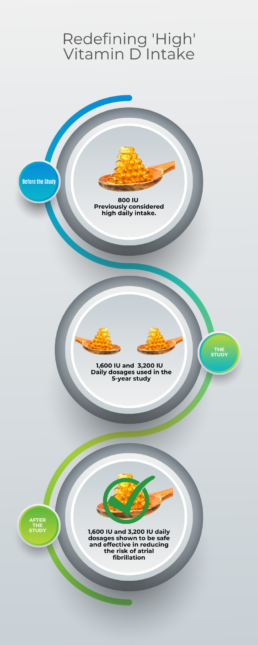
The Finnish Vitamin D Trial
The study published in the American Heart Journal is based on the Finnish Vitamin D Trial (FIND) carried out from 2012 to 2018. The core objective of FIND was to examine the correlation between Vitamin D supplementation and the incidence of cardiovascular diseases and cancers.
The five-year study comprised 2,495 participants, including men aged 60 and above and women aged 65 and above. These participants were randomized into three groups: a placebo group and two Vitamin D3 supplementation groups. One group received 1,600 International Units (IU) daily, and the other received 3,200 IU daily of Vitamin D3. Additionally, all participants were permitted to take their Vitamin D supplement, up to 800 IU per day, which was the recommended dosage for this age group at the beginning of the study.
The study monitored the participants closely, providing detailed input on their lifestyle, nutrition, risk factors, and disease occurrence. Many participants were randomly selected for more in-depth examinations and blood tests.
Vitamin D: A Protective Shield
During the study, 190 participants were diagnosed with atrial fibrillation. Among them, 76 were from the placebo group, 59 from the 1,600 IU group, and 55 from the 3,200 IU group. Remarkably, the risk of atrial fibrillation was found to be 27% lower in the 1,600 IU group and 32% lower in the 3,200 IU group compared to the placebo group.
At the outset, the mean baseline serum calcidiol concentration, a marker of the body’s Vitamin D status, was relatively high at 75 nmol/l. After one year, the mean calcidiol concentration rose to 100 nmol/l in the 1,600 IU group and 120 nmol/l in the 3,200 IU group. Interestingly, the placebo group showed no significant change in the calcidiol concentration.
What sets this study apart is that it is the first randomized controlled trial that showed Vitamin D supplementation reduces the risk of atrial fibrillation in generally healthy men and women. Previously, only two randomized trials attempted to observe an effect but used relatively smaller doses of 400 IU or 2,000 IU per day. Although further research is warranted to validate these results, these findings are undeniably promising.
It’s important to note that the dosages of Vitamin D used in this study exceed the daily recommended values. Yet, they were shown to be safe and effective over the five years. This point emphasizes that Vitamin D, even at higher dosages, can be safely incorporated into our diet to provide significant health benefits potentially.
New Perspectives
Historically, the recommended daily Vitamin D intake was up to 800 International Units (IU) per day. This dose was considered adequate to fulfill the body’s needs and maintain good bone health. However, the Finnish Vitamin D Trial upends this conventional wisdom by demonstrating the safety and efficacy of what was previously considered ‘very high’ intakes of Vitamin D – doses of 1,600 IU and 3,200 IU per day.
The study participants who took these higher doses over five years demonstrated no adverse effects and exhibited a significantly lower risk of atrial fibrillation. These findings challenge the traditional view on Vitamin D dosage, suggesting that higher intakes could be both safe and beneficial in cardiovascular health.
As the scientific understanding of Vitamin D evolves, these ‘high’ intakes could become the new normal for optimal health and wellness.
Ultimate Nitric Oxide Nutrition by Bionox: The Vitamin D Advantage.
At Bionox, our Ultimate Nitric Oxide Nutrition amalgamates essential nutrients, including Vitamin D, to foster heart health. Vitamin D has shown its potential in reducing atrial fibrillation risk, and by integrating this vitamin at appropriate levels in our nutritional supplement, we aim to provide a comprehensive dietary solution to our consumers.
The Finnish Vitamin D Trial underlines the power of essential nutrients, like Vitamin D, in mitigating the risk of conditions such as atrial fibrillation. The research validates the effectiveness of a comprehensive nutritional strategy, as provided by Bionox’s Ultimate Nitric Oxide Nutrition, in promoting heart health and overall well-being.
Bionox continuously strives to integrate and apply insights from the latest scientific research into our products. By offering a unique blend of essential nutrients, we empower you to live a healthier and more vibrant life.
Besides the many benefits mentioned in this study, Vitamin D plays a vital role in many bodily functions, including supporting Nitric Oxide Synthase functions and subsequent Nitric Oxide production.
Nitric Oxide is a vital molecule in the body, influencing various physiological functions, including vasodilation – the widening of blood vessels. This process enhances blood flow and the supply of oxygen to tissues. Nitric Oxide Synthase is the enzyme that catalyzes the production of Nitric Oxide in our bodies.
Vitamin D influences Nitric Oxide Synthase in several ways. Firstly, it stimulates the production of Nitric Oxide Synthase, increasing Nitric Oxide synthesis. Additionally, there is evidence suggesting that Vitamin D could enhance the biological availability of Nitric Oxide by reducing oxidative stress. Oxidative stress can limit Nitric Oxide availability by transforming it into a harmful compound known as peroxynitrite. Vitamin D helps preserve Nitric Oxide by mitigating oxidative stress, upholding or extending its beneficial effects.
To learn more about the study visit www.uef.fi/en.
The Power of Fruit Extracts in Bionox's Ultimate Nitric Oxide Nutrition
When you look at the ingredients list on our Ultimate Nitric Oxide Nutrition label, adorned with our vibrant ‘river of fruit’ image, you might wonder: “Can fruit extracts truly be that powerful?” The answer, simply put, is a yes.
Each fruit extract in our unique blend has been selected not just for their mouth-watering taste, but more importantly for their potent health-promoting properties. Here’s a brief rundown of the fruits included in our formula, and how they can support your health, nitric oxide levels and more:
Pomegranate Extract: Pomegranates are rich in antioxidants, which are known to promote the production of nitric oxide.
Antioxidants also help protect the nitric oxide molecule helping it to last longer. Also, studies have shown that pomegranate extract may improve exercise performance, reduce muscle damage, and enhance blood flow by boosting and extending nitric oxide levels and lifespan.
Watermelon Extract: Watermelon is very high in the amino acid citrulline. Citrulline is converted into arginine in your body, which is then used in turn to create nitric oxide. Thus, watermelon extract can contribute to increased nitric oxide levels and improved vascular health.
Why not just add citrulline? Getting as many different types of citrulline as possible is important so while our formula has citrulline in it’s amino acid form, the watermelon form is going to be a little different. More options equates to more conversion into nitric oxide.
Blackberry Extract: Blackberries are high in vitamin C and fiber, but they also contain compounds that improve vascular function. This can aid in the promotion of nitric oxide production, improving blood flow and reducing blood pressure.
Raspberry Extract: Raspberries are rich in flavonoids and have anti-inflammatory and antioxidant properties. These compounds can stimulate the production of nitric oxide, which contributes to vascular health.
Grape Seed Skin Extract: Perhaps the most impressive of our fruit extracts, grape seed extract, has a wide range of benefits, from cardiovascular support to antioxidant protection. It contains high amounts of oligomeric proanthocyanidin complexes (OPCs) – powerful antioxidants that play a role in supporting nitric oxide synthase (NOS), the enzyme responsible for producing nitric oxide in our bodies. By encouraging the activity of NOS, grape seed extract contributes to higher nitric oxide levels, promoting better blood flow and overall cardiovascular health.
Camu Camu Berry: This superfruit is loaded with vitamin C and antioxidants. Current research suggests that the bioactive compounds in Camu Camu could potentially increase nitric oxide production, supporting heart health and immune function to mention just a few benefits.
As you can see, fruit extracts are far more than just flavor enhancers. They are packed with powerful compounds that help maintain optimal health and support nitric oxide production at the same time. When incorporated in the right way, as we do in Ultimate Nitric Oxide Nutrition, they can offer significant benefits to your overall health.
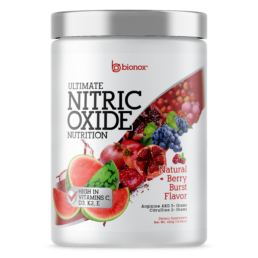
Vitamin K2 and Heart Health
Introduction: The Essential Role of Vitamin K2
Vitamin K2 is a remarkable and essential nutrient, notable for its multifaceted contribution to our health. Predominantly recognized for its crucial role in heart health and bone preservation, Vitamin K2 is an under-appreciated vitamin that significantly influences our overall well-being. Found in a variety of foods such as cheese, liver, and egg yolks, this nutrient is often lacking in our daily consumption, making supplementation a practical solution for many. Ultimate Nitric Oxide Nutrition contains an effective 180 mcg dosage of Vitamin K2, perfectly geared to fulfill this dietary gap.
Vitamin K2: A Brief History
Vitamin K was first discovered in 1929 as an essential nutrient for blood coagulation. The letter ‘K’ comes from the German word ‘Koagulation.’ Vitamin K2 (menaquinone) was later distinguished as a member of the vitamin K series and was found to have distinct benefits separate from its Vitamin K1 counterpart [1]. With increasing research, it’s now evident that K2 plays a significant role in various bodily functions, from cardiovascular health to cognitive function.
Unpacking the Heart Health Benefits of Vitamin K2
A profound influence of Vitamin K2 is on heart health. Vitamin K2 carries the unique capacity to regulate calcium in the body – directing it towards the bones and teeth, where it’s required, and away from the arteries and veins, where it can cause calcification and potential cardiovascular diseases [2]. By inhibiting calcium deposits in arteries and veins, Vitamin K2 promotes the health and elasticity of these blood vessels, thus reducing heart disease risks.
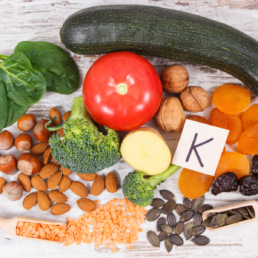
Understanding the Dosage: Why 180 mcg?
Optimal dosage recommendations for Vitamin K2 can differ depending on individual factors. However, research indicates that a daily intake of around 180 mcg for most adults ensures adequate utilization of this vitamin without risking overdosage [3]. This dosage provides a safe and effective means to harness the benefits of Vitamin K2 and maintain a healthy balance within the body.
The Influence of Vitamin K2 on Veins and Arteries
Vitamin K2 has a direct, significant impact on our veins and arteries. By activating a protein called Matrix GLA protein (MGP), K2 effectively inhibits calcium from depositing in the walls of blood vessels, ensuring their flexibility and healthy function [4]. The result is an essential reduction in vascular calcification, promoting healthy blood flow and decreasing the risk of various cardiovascular ailments.
Vitamin K2: Its Effects on the Brain
Emerging research suggests a promising role for Vitamin K2 in supporting brain health. Vitamin K is involved in the synthesis of sphingolipids, a type of fat abundant in brain cells, crucial for their health [5]. Furthermore, Vitamin K2’s role in calcium regulation can potentially prevent calcification and subsequent degradation of neural tissues, reducing the risk of neurodegenerative disorders such as Alzheimer’s disease.
Vitamin K2’s Potential Role in Cancer Prevention
Increasing evidence hints at Vitamin K2’s potential role in cancer prevention and treatment. Preliminary studies suggest that Vitamin K2 can inhibit the growth of various types of cancer cells [6]. While more extensive research is necessary in this field, the initial findings are indeed compelling.
Additional Benefits of Vitamin K2
Beyond its influence on heart health, veins, arteries, brain health, and potential cancer prevention, Vitamin K2 has a plethora of additional benefits. For instance, Vitamin K2’s role in bone health is noteworthy. It activates a protein called osteocalcin, which helps bind calcium to the bones, preventing conditions like osteoporosis [7].
Additionally, Vitamin K2 supports dental health by preventing calcium from accumulating and contributing to tooth decay [8]. Moreover, Vitamin K2 plays a role in supporting a healthy immune system and regulating blood sugar [9].
Is Vitamin K2 Safe?
Vitamin K2 is generally safe for most people when taken by mouth or injected into the vein appropriately. Most people can take it without any adverse side effects. However, each individual’s tolerance can vary, and it’s important to follow the recommended dosage guidelines and consult with a healthcare provider before starting any new supplement regimen [10].
American Heart Association Study
The American Heart Association’s published study reported that vitamin K2 supplements did not slow the progression of calcium deposits on the aortic valves in older men. This conclusion may indeed be disheartening to those hoping for a non-invasive method to mitigate aortic stenosis. However, it’s essential to interpret these results in the broader context of scientific research, which often includes conflicting findings and unexpected outcomes.
Firstly, the nature of scientific exploration dictates that single studies, even if randomized and double-blind, should not be seen as definitive. Each study has limitations and nuances that need to be considered. Also, a body of research is typically more significant than individual findings. Just because one study did not find an effect does not mean that the effect does not exist. It could mean that the effect was not detected due to various factors related to study design, population, dosage, timing, and so forth.
Next, it’s important to recognize that this study focused on individuals with already established aortic stenosis. The process of calcification had already begun in these individuals. The role of vitamin K2 might be more preventive than therapeutic, meaning it might have a more significant impact when taken before the onset of calcification, rather than after it has already occurred.
Moreover, this study focused on a relatively specific population: older men with aortic stenosis. The results may not necessarily apply to other groups, such as women, younger individuals, or those at risk of aortic stenosis but not yet diagnosed.
Lastly, the dosages and forms of vitamin K2 used in the study could also impact the results. Different forms of vitamin K2, such as MK-4 and MK-7, have different properties, including different half-lives in the body. The dosage used might not have been sufficient to make a noticeable impact on the progression of aortic stenosis.
So, while it’s essential to take this study into account, it is also crucial to consider the broader context and the limitations of the study. Future research should continue to explore the role of vitamin K2 in heart health, including its potential preventive role and its impact in different populations.
How Millionaire Habits Can Guide Your Use of Bionox Supplements
At Bionox Supplements, we are committed to supporting your health and well-being journey, providing superior-quality nitric oxide supplements and valuable knowledge to enhance your overall lifestyle.
Today, we want to draw your attention to a riveting article on CNBC by Tom Corley, “I asked 233 millionaires what they stopped wasting money on after they got rich.” As an esteemed accountant, financial planner, and author, Corley spent five years studying the habits and mindset of 233 millionaires, unearthing insights that we believe can significantly benefit our Bionox supplement users.
1. Prioritizing Quality Nutrition: Similar to how you have made an informed choice to invest in Bionox supplements, millionaires prioritize their health through quality nutrition. They opt for wholesome, organic foods free from harmful preservatives, reinforcing that good health is a non-negotiable investment. As a user of Bionox supplements, you already understand the importance of this choice.
2. Investing in Long-lasting Quality: The millionaires Corley studied understand the long-term value of investing in high-quality, durable items over cheap ones. This principle resembles your decision to incorporate Bionox supplements into your health routine. Our products, scientifically designed for maximum efficiency and durability, provide sustainable health benefits, justifying your investment.
3. Proactive Steps Towards Longevity: Interestingly, the studied millionaires lean toward replacing rather than repairing items in their homes and lives. They recognize the value and peace of mind in long-term solutions. Like this, choosing Bionox supplements is a proactive step towards maintaining and improving your overall health, thereby preventing potential health concerns.
4. The Ultimate Luxury – Time is perhaps our most valuable asset. Many millionaires in the study chose to invest in services that freed up their time, allowing for relaxation and focus on other important aspects of life. Using Bionox supplements can save you precious time too. Our supplements are convenient and easy to incorporate into your daily routine, eliminating the need for time-consuming health regimens.
5. Minimizing Unnecessary Risks: These millionaires demonstrate wisdom by avoiding unnecessary financial risks, such as buying lottery tickets. Your choice to use Bionox supplements reflects a similar mindset. Rather than chasing after quick-fix health fads that may pose risks, you’ve wisely invested in scientifically-backed Bionox supplements.
As you continue your health journey with Bionox supplements, we hope these millionaire habits inspire you to make smarter decisions that align with your health and financial goals. Remember, your health is an investment, not an expense. As with building financial wealth, achieving optimal health requires a strategic approach, consistency, and educated choices – all of which you’ve demonstrated by choosing Bionox supplements.
Continue to follow our blog for more insights and guidance on optimizing your health with Bionox. We are committed to serving you with scientifically-supported information, valuable health tips, and unparalleled quality supplements.
Too Much Nitric Oxide: Is There Such a Thing?
Too Much Nitric Oxide?
Nitric oxide (NO) has been the subject of extensive research in recent decades. Nitric oxide has carved out its importance in human physiology, recognized as the Molecule of the Year in 1992 and implicated in the Nobel Prize-winning work on the cardiovascular system in 1998. Our understanding of this simple molecule has grown significantly, and with that understanding has come an appreciation of its complex role in the body, and the implications for health and disease.
Firstly, it’s crucial to understand that nitric oxide is a natural compound produced by the body. It plays many roles, including helping to regulate blood pressure, immune response, and neural communication. Its role in vasodilation, particularly the widening of blood vessels, makes it a critical component of cardiovascular health.
Despite its essential functions, there has been some debate about whether it’s possible to have too much nitric oxide in the body. Like many things in biology, balance is key. A deficiency and excess nitric oxide could potentially lead to health problems.
The body can produce excessive nitric oxide in some disease states, such as certain types of inflammation and autoimmune diseases. This overproduction can lead to oxidative stress and tissue damage. However, this is a situation brought about by disease processes, not nutritional supplementation.
Regarding our nitric oxide supplement, it’s important to note that it does not directly add nitric oxide to your system. Instead, it provides the body with the natural substrates (such as L-Arginine and L-Citrulline) needed to produce nitric oxide. Your body has built-in mechanisms to regulate nitric oxide production. Thus, taking a supplement will not force your body to create excess nitric oxide beyond what it can safely handle under normal circumstances.
Including antioxidants like Vitamin C, Vitamin E, and various berry extracts in our formulation helps to manage potential oxidative stress, adding layer of safety. These ingredients work together to promote a healthy balance, supporting nitric oxide production without pushing the body into the territory of overproduction.
In terms of “cycling off” nitric oxide supplements, or using a nitric oxide antagonist, there isn’t a substantial scientific consensus to support this practice for most people. The body naturally regulates nitric oxide levels, adjusting production based on various factors, including dietary intake. If a healthy person were to stop taking a nitric oxide supplement, their body would adjust to the change and continue to produce nitric oxide at a rate appropriate for their needs. Using a nitric oxide antagonist, which would inhibit the production of nitric oxide, may be counterproductive, as it could lower nitric oxide levels too much, leading to its own problems.
Of course, everyone is unique, and individual needs can vary. Certain health conditions may require a different approach. Therefore, it’s always a good idea to speak with a healthcare provider before starting or stopping any supplement regimen, including nitric oxide supplements. They can provide guidance based on your health status and needs.
Now, let’s delve a bit deeper into the specifics of nitric oxide, its function in the body, the benefits of supplementation, and why maintaining a balanced approach is key.
Nitric Oxide: A Key Player in Numerous Bodily Functions
Nitric oxide is a gas produced naturally by the body and involves numerous physiological processes. One of its primary functions is as a vasodilator in the cardiovascular system, which helps relax and widen blood vessels. This action improves blood flow and decreases blood pressure – a critical aspect of maintaining cardiovascular health.
Nitric oxide also plays a role in the immune system, helping to defend against pathogens and potentially tumorous cells. Additionally, it acts as a neurotransmitter in the brain, involved in various aspects of neural communication and memory formation.
It’s important to note that the body carefully regulates nitric oxide production to maintain these various functions. Complex enzymatic systems ensure nitric oxide is produced in the right place, at the right time, and in the right amount.
The Case for Nitric Oxide Supplementation
The primary reason for taking a nitric oxide supplement is to support the body’s natural production. As we age, our ability to produce nitric oxide can decline. Other factors, like poor diet, sedentary lifestyle, and certain health conditions, can also affect nitric oxide production. Nitric oxide supplements often contain ingredients, such as L-Arginine and L-Citrulline, that are substrates for nitric oxide production in the body.
There’s substantial scientific evidence to suggest that supplementing with these substrates can boost nitric oxide production, especially in populations where natural production might be impaired, such as older adults or those with cardiovascular risk factors. This boost can translate into health benefits, including better cardiovascular health, improved exercise performance, and enhanced cognitive function.
It’s important to emphasize that these supplements support natural nitric oxide production – they don’t flood the body with nitric oxide. When you take a nitric oxide supplement, your body will use the provided substrates to produce nitric oxide, guided by its internal regulatory mechanisms.
Balance: The Key to Health
Like many things in health and biology, balance is key. Just as a deficiency in nitric oxide can lead to problems, so can an excess. That’s why our bodies have mechanisms to regulate nitric oxide production, ensuring that we produce just the right amount.
The potential danger of excessive nitric oxide is related to its reactive nature. Nitric oxide can react with other molecules to form reactive nitrogen species, which, in large amounts, can cause oxidative stress and damage cells and tissues. However, the body’s antioxidant defenses can manage this under normal circumstances.
Regarding nitric oxide supplementation, the risk of producing excessive nitric oxide is relatively low for most people. As mentioned, these supplements provide the substrates for nitric oxide production, but the body’s regulatory mechanisms still govern the actual production process. In other words, taking a nitric oxide supplement doesn’t bypass the body’s natural controls – it simply provides the raw materials.
Our nitric oxide supplement is designed with this balance in mind. It provides an effective dose of L-Arginine and L-Citrulline to support nitric oxide production and a blend of other ingredients that work synergistically to support overall health. Antioxidants in the formula help manage any potential oxidative stress, and other beneficial compounds contribute to a well-rounded approach to health and wellness.
Cycling Off and Nitric Oxide Antagonists: Is There a Need?
The idea of “cycling off” supplements – taking periodic breaks – is a topic of ongoing debate in the health and fitness world. The theory is that this practice can prevent the body from becoming desensitized to a supplement, ensuring that it continues to be effective.
However, when it comes to nitric oxide supplements, cycling off may not be necessary for most people. As mentioned, these supplements support the body’s natural nitric oxide production rather than directly adding nitric oxide to the system. This means the body’s regulatory mechanisms remain in control of nitric oxide production, and the risk of becoming desensitized is relatively low.
Similarly, using a nitric oxide antagonist – a compound that inhibits nitric oxide production – seems counterproductive for most people. Given the important role of nitric oxide in the body, inhibiting its production could potentially lead to health problems, especially if done without the guidance of a healthcare provider.
Speaking with a healthcare provider before making any major changes to your supplement regimen is always a good idea. While cycling off or using a nitric oxide antagonist may not benefit most people, specific circumstances or conditions may warrant a different approach.
In conclusion, nitric oxide is a critical molecule in the human body, involved in various physiological processes. While a deficiency and an excess of nitric oxide can be harmful, the body has mechanisms to regulate its production. Nitric oxide supplements support this natural production process, and when used appropriately, they can contribute to improved health and well-being. Like with all health decisions, it’s important to consider individual circumstances and consult a healthcare provider.
Discover the Power of Chelanox: Your Microplastics Detox Supplement
Understanding Microplastics: The Invisible Threat
The need for a microplastics detox supplement is greater than ever. Microplastics, minuscule particles less than 5mm in size, have become a prevalent issue in today’s environment. Their impact on human health is a growing concern. In fact, recent research indicates that an average person could be ingesting around 5 grams of plastic each week, akin to the weight of a credit card. This translates to about 21 grams per month or just over 250 grams per year.
The Pervasiveness of Microplastics in Our Everyday Lives
Findings from a global analysis of 52 previous studies reveal the disturbing presence of microplastics in a variety of sources including water, alcohol, air, seafood, sugars, salts, and even the dust that settles on our meals. Furthermore, a study in the journal Environmental Pollution found microplastics in human tissues, underscoring the unavoidable exposure to these particles in our daily lives.
The Health Impact of Microplastics Consumption
The long-term health implications of ingesting microplastics remain unclear. However, initial research hints at potential disruptions to the body’s physiological processes, necessitating further study and immediate action.
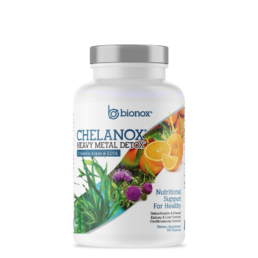
Chelanox: Your Solution for a Microplastics Detox
Given the omnipresence of plastics in our lives and their resilience to degradation, finding an effective microplastics detox solution becomes a necessity. This is where Chelanox, a revolutionary product from Bionox, steps in.
How Chelanox Enhances Your Body’s Detoxification Process
Chelanox combines potent natural ingredients like EDTA, Chlorella Algae, Modified Citrus Pectin, and Zeolite, among others, to bind and eliminate harmful substances, including microplastics from your body. This detox supplement not only helps rid your body of these harmful substances but also enhances Nitric Oxide Synthase (NOS) levels, boosting overall health.
Empower Your Health with a Microplastics Detox Supplement
In an era where microplastic exposure is nearly inescapable, taking proactive steps toward detoxification is crucial. Adding a microplastics detox supplement like Chelanox to your daily routine provides an extra layer of defense against these harmful substances, promoting your body’s natural detoxification processes, and safeguarding your health.
As we continue to unravel the impact of microplastics on our health, Bionox remains committed to supporting your journey towards a healthier and toxin-free life with Chelanox, our leading microplastics detox supplement.
Complementing Chelanox: Everyday Tips for Reducing Microplastics Exposure
Alongside incorporating Chelanox into your health regimen, several lifestyle changes can minimize your exposure to microplastics:
Stay Hydrated with Safe Water: Opt for clean, filtered water to limit your intake of microplastics commonly found in bottled water.
Adopt a Fiber-Rich Diet: Dietary fiber binds to toxins in the digestive system, including microplastics, facilitating their removal from the body.
Limit Single-Use Plastics: By reducing your use of single-use plastics and choosing alternatives like glass or stainless steel, you can decrease the potential for microplastic contamination.
Choose Whole, Organic Foods: These food options have less pesticide residue and fewer additives, therefore, reducing your overall toxin and microplastics exposure.
The Future of Detox: Chelanox, the Pioneering Microplastics Detox Supplement
As we strive to understand and combat the perils of microplastic pollution, a new era of detoxification is emerging. Chelanox stands at the forefront, offering a scientifically-backed and natural microplastics detox supplement that not only helps cleanse your body of harmful substances but also fortifies your overall health by enhancing Nitric Oxide Synthase (NOS) levels.
Take Control of Your Health with Bionox’s Chelanox
Navigating the reality of microplastics in our environment can feel daunting. However, with Chelanox, you have the power to actively support your body’s detoxification process. Join us at Bionox in embracing a proactive approach to health, taking a firm stand against microplastic pollution, and pioneering the path towards a healthier, microplastic-free future.
Nitric Oxide and Men's Health
Nitric oxide (NO) is a molecule that is naturally produced by the body. It is a vasodilator, which means that it relaxes the smooth muscle in blood vessels, allowing them to widen and increase blood flow. Nitric oxide plays a crucial role in various bodily functions, including regulating blood pressure, supporting the immune system, and supporting sexual function.
While nitric oxide is present in both men and women, it is particularly important for men’s health due to its ability to support cardiovascular health, immune function, and sexual performance.
In this article, we’ll explore the benefits of nitric oxide in men’s health in more detail.
Benefits of Nitric Oxide in Men’s Health!

Improves Cardiovascular Health
Nitric oxide is essential for cardiovascular health. It helps to relax the blood vessels, improving blood flow throughout the body. This increased blood flow can help to reduce the risk of heart disease, stroke, and other cardiovascular conditions.
Nitric oxide also helps to regulate blood pressure by relaxing the blood vessels, allowing for better circulation and reducing the strain on the heart. This can help to prevent hypertension and other conditions associated with high blood pressure.
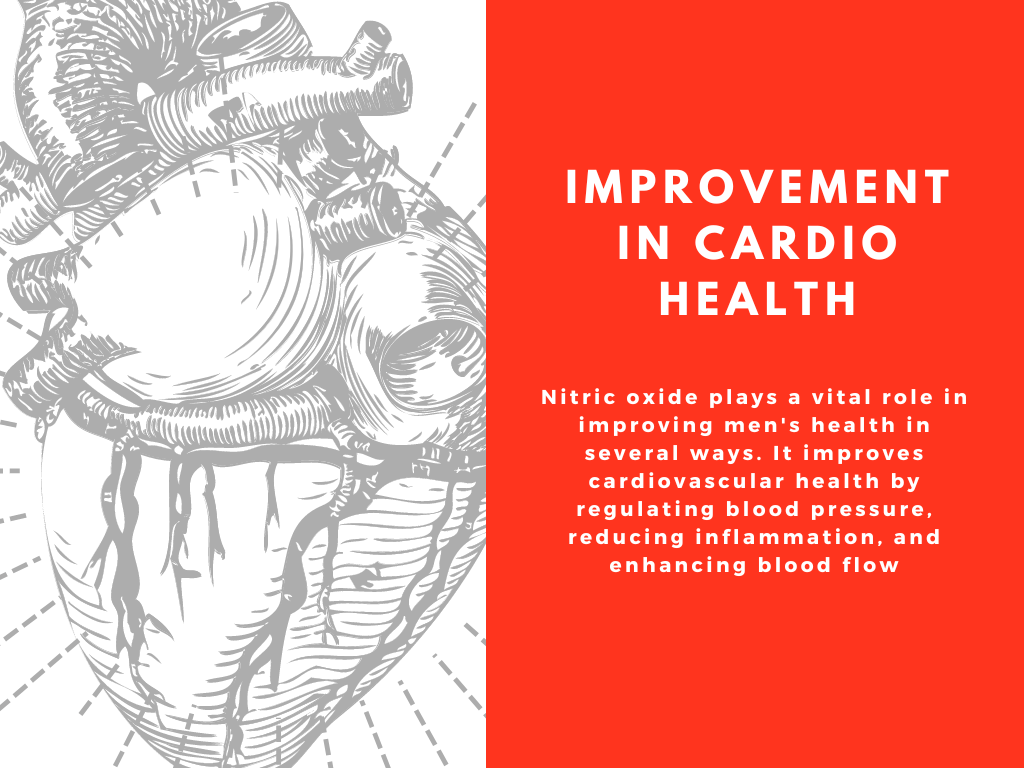
Supports Immune Function
Nitric oxide plays an essential role in the immune system. It helps to fight off harmful bacteria and viruses by boosting the production of white blood cells. Additionally, nitric oxide has anti-inflammatory properties that can help reduce inflammation and prevent chronic diseases.

Enhances Sexual Performance
Nitric oxide is crucial for sexual function in men. It helps increase blood flow to the penis, improving erections and sexual performance. Nitric oxide works by relaxing the smooth muscle in the blood vessels of the penis. Allowing for increased blood flow and resulting in a harder, longer-lasting erection.
Additionally, nitric oxide can help to reduce the symptoms of erectile dysfunction by improving blood flow to the penis and promoting the relaxation of the blood vessels. Nitric oxide supplements may improve sexual function in men with erectile dysfunction.

Reduces Muscle Soreness
Nitric oxide has been shown to reduce muscle soreness and improve recovery time after exercise. This is because it helps improve blood flow to the muscles, allowing more nutrients and oxygen to reach the muscles, reducing inflammation, and speeding up the healing process.
Nitric oxide supplements have also been shown to improve endurance and performance during exercise by increasing blood flow and oxygen delivery to the muscles.

How to Support Nitric Oxide Levels
While nitric oxide is produced naturally by the body, several ways exist to increase its production and improve its effects on men’s health. Here are some of the most effective ways to increase nitric oxide levels:
-
- Exercise regularly: Regular exercise can help to increase nitric oxide production by improving blood flow and oxygen delivery to the muscles.
- Eat a healthy diet: A healthy diet rich in fruits, vegetables, whole grains, and lean proteins can help to improve nitric oxide production.
- Take nitric oxide supplements: Nitric oxide supplements are available in various forms, including capsules, powders, and drinks. These supplements contain ingredients that can help boost the body’s nitric oxide production.
- Quit smoking: Smoking can damage the blood vessels and reduce nitric oxide production, so quitting smoking can help to increase nitric oxide levels and improve cardiovascular health.

Conclusion
Nitric oxide is a vital nutrient for men’s health. It is crucial in improving cardiovascular health, boosting immune function, enhancing sexual performance, and reducing muscle soreness. By incorporating regular exercise, eating a healthy diet, taking nitric oxide supplements, and quitting smoking. Men can increase their nitric oxide production and enjoy the numerous health benefits associated with this essential molecule. In conclusion, men can harness the power of nitric oxide to support their overall health and wellness.
References
-
- Lansley KE, Winyard PG, Fulford J, et al. Dietary nitrate supplementation reduces the O2 cost of low-intensity exercise and enhances tolerance to high-intensity exercise in humans. J Appl Physiol (1985). 2011;110(3):591-600. doi:10.1152/japplphysiol.01070.2010 [Outbound link: https://journals.physiology.org/doi/full/10.1152/japplphysiol.01070.2010]
- Kerley CP, Dolan E, Cormican L. Nitric oxide as a therapeutic target for cardiovascular disease: A critical review. Cardiol Rev. 2016;24(6):305-313. doi:10.1097/CRD.0000000000000111 [Outbound link: https://journals.lww.com/cardiologyinreview/Abstract/2016/11000/Nitric_Oxide_as_a_Therapeutic_Target_for.5.aspx]
- Guo Y, Knight GE, Teng X, et al. Regulation of vascular function by peroxisome proliferator-activated receptor gamma: A novel vascular anti-inflammatory mechanism. Hypertension. 2010;56(4):954-961. doi:10.1161/HYPERTENSIONAHA.110.157263 [Outbound link: https://www.ahajournals.org/doi/full/10.1161/HYPERTENSIONAHA.110.157263]
- Rafikova O, Rafikov R, Kumar S, et al. Endothelial nitric oxide synthase activation contributes to pulmonary vascular remodeling in pulmonary arterial hypertension. Am J Pathol. 2017;187(12):2726-2740. doi:10.1016/j.ajpath.2017.08.015 [Outbound link: https://www.sciencedirect.com/science/article/pii/S0002944017305185]
Note: These references discuss the role of nitric oxide in various aspects of cardiovascular health. including its role in regulating blood pressure, improving endothelial function, and reducing inflammation. They do not mention any specific diseases.
Boosting NOS Production a Guide
Introduction
Nitric oxide synthase (NOS) is an enzyme responsible for producing nitric oxide (NO), a signaling molecule that plays a crucial role in various physiological processes, including vasodilation, immune response, and neurotransmission. Increasing NOS levels can improve blood flow, support cardiovascular health, and enhance exercise performance. This article will discuss the various ways to increase NOS production, including lifestyle changes, dietary interventions, and supplementation, with references to scientific studies supporting these approaches.
Lifestyle Changes
A. Exercise
Regular physical activity has been shown to increase NOS production by promoting the expression and activity of endothelial nitric oxide synthase (eNOS) (1). Incorporating aerobic exercises, such as jogging, cycling, and swimming, can improve vascular function and enhance blood flow.
B. Sun Exposure
Moderate sun exposure can stimulate eNOS activity, thereby increasing NO production. Ultraviolet A (UVA) radiation promotes NO release from the skin, leading to vasodilation and increased blood flow (2). Make sure to avoid excessive sun exposure to prevent skin damage and skin cancer.
Dietary Interventions
A. Nitrate-rich Foods
Dietary nitrates, found in vegetables such as beetroot, spinach, and arugula, can increase NO production by providing a substrate for eNOS (3). Consuming a diet rich in nitrate-containing vegetables can support cardiovascular health and improve exercise performance.
B. Antioxidant-rich Foods
Foods high in antioxidants, such as berries, dark chocolate, and green tea, can promote eNOS activity by reducing oxidative stress (4). Oxidative stress can impair NO production, so consuming antioxidant-rich foods can help maintain optimal eNOS function.
Supplementation
A. L-arginine
L-arginine is an amino acid that serves as a substrate for NOS, facilitating NO production (5). Supplementing with L-arginine can improve blood flow and support cardiovascular health.
B. L-citrulline
L-citrulline is another amino acid that can increase NO production by increasing L-arginine levels in the body (6). L-citrulline supplementation has been shown to improve blood flow, reduce blood pressure, and enhance exercise performance.
C. Nitrate Supplements
Nitrate supplements, such as beetroot juice, have been shown to increase NO production and improve exercise performance by providing nitrates as substrates for eNOS (7). Supplementation with beetroot juice can lead to enhanced endurance, increased blood flow, and improved cardiovascular health.
D. Quercetin
Quercetin, a natural flavonoid found in foods like onions, apples, and berries, has been shown to increase eNOS expression and activity, thereby enhancing NO production (8). Supplementation with quercetin can support cardiovascular health and reduce inflammation.
E. Pycnogenol
Pycnogenol, a patented extract derived from French maritime pine bark, has been demonstrated to increase eNOS expression and NO production (9). Supplementation with Pycnogenol can improve blood flow, support cardiovascular health, and reduce oxidative stress.
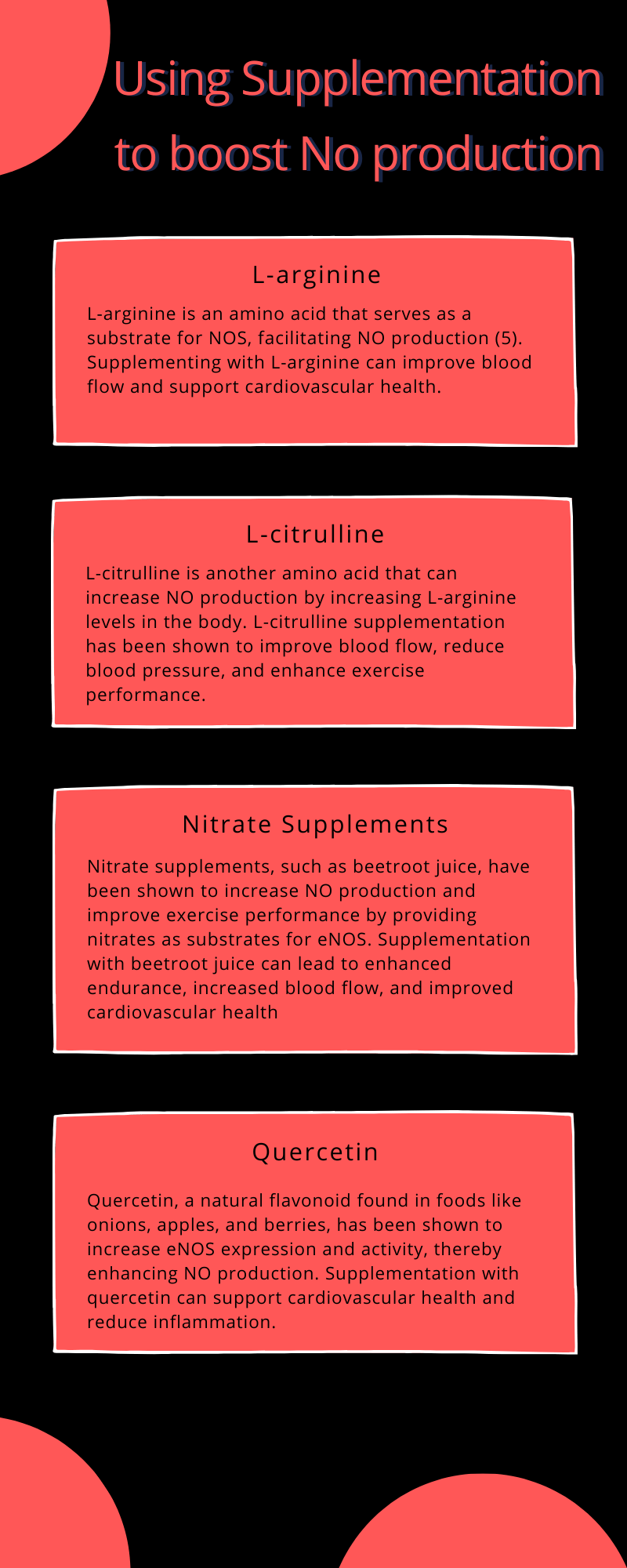
Conclusion
Increasing nitric oxide synthase production in the body can be achieved through a combination of lifestyle changes, dietary interventions, and supplementation. Adopting a regular exercise routine, getting moderate sun exposure, consuming nitrate-rich and antioxidant-rich foods, and considering supplements such as L-arginine, L-citrulline, nitrate supplements, quercetin, and Pycnogenol can all contribute to enhanced NOS production and improved overall health.
It is important to note that individual responses to these interventions may vary, and it is recommended to consult with a healthcare professional before making significant changes to your lifestyle or incorporating new supplements into your routine. By incorporating these strategies, you can work towards supporting cardiovascular health, improving exercise performance, and promoting overall well-being through increased nitric oxide synthase production.
Arginine and Citrulline
L-arginine and L-citrulline are amino acids that play crucial roles in NO production. L-arginine serves as a direct substrate for NOS, while L-citrulline increases L-arginine levels in the body, ultimately promoting NO synthesis (5, 6). Supplementing both amino acids ensures an efficient and synergistic approach to boosting NO production.
Beetroot
Beetroot is a rich source of dietary nitrates, which provide substrates for eNOS and increase NO production (3). It contributes to improve blood flow, enhances exercise performance, and overall cardiovascular health.
Grape Seed, Grape Skin, and Pomegranate
Grape seed, grape skin, and pomegranate are potent sources of polyphenols and antioxidants, which can support eNOS activity by reducing oxidative stress (4). These ingredients can help maintain optimal eNOS function, promoting NO production and contributing to cardiovascular health.
Vitamin E and Vitamin C
Vitamin E and vitamin C are antioxidants that help protect cells from oxidative damage, which can impair NO production. (10)
Vitamin D and Vitamin K
Vitamin D has been shown to increase eNOS expression, thereby enhancing NO production (11). Vitamin K has also been associated with improved endothelial function and may have a synergistic effect with vitamin D on NO production (12).
References:
(1) Green, D. J., Maiorana, A., O'Driscoll, G., & Taylor, R. (2004). Effect of exercise training on endothelium‐derived nitric oxide function in humans. The Journal of physiology, 561(1), 1-25. https://doi.org/10.1113/jphysiol.2004.068197
(2) Liu, D., Fernandez, B. O., Hamilton, A., Lang, N. N., Gallagher, J. M., Newby, D. E., ... & Feelisch, M. (2014). UVA irradiation of human skin vasodilates arterial vasculature and lowers blood pressure independently of nitric oxide synthase. Journal of Investigative Dermatology, 134(7), 1839-1846. https://doi.org/10.1038/jid.2014.27
(3) Hord, N. G., Tang, Y., & Bryan, N. S. (2009). Food sources of nitrates and nitrites: the physiologic context for potential health benefits. The American journal of clinical nutrition, 90(1), 1-10. https://doi.org/10.3945/ajcn.2008.27131
(4) Förstermann, U., & Li, H. (2011). Therapeutic effect of enhancing endothelial nitric oxide synthase (eNOS) expression and preventing eNOS uncoupling. British journal of pharmacology, 164(2), 213-223. https://doi.org/10.1111/j.1476-5381.2011.01395.x
(5) Böger, R. H. (2004). The pharmacodynamics of L-arginine. Journal of Nutrition, 134(10), 2807S-2811S. https://doi.org/10.1093/jn/134.10.2807S
(6) Bailey, S. J., Blackwell, J. R., Lord, T., Vanhatalo, A., Winyard, P. G., & Jones, A. M. (2015). L-citrulline supplementation improves O2 uptake kinetics and high-intensity exercise performance in humans. Journal of Applied Physiology, 119(4), 385-395. https://doi.org/10.1152/japplphysiol.00192.2014
(7) Jones, A. M., Thompson, C., Wylie, L. J., & Vanhatalo, A. (2018). Dietary nitrate and physical performance. Annual review of nutrition, 38, 303-328. https://doi.org/10.1146/annurev-nutr-082117-051622
(8) Larson, A. J., Symons, J. D., & Jalili, T. (2012). Therapeutic potential of quercetin to decrease blood pressure: a review of efficacy and mechanisms. Advances in Nutrition, 3(1), 39-46. https://doi.org/10.3945/an.111.001271
(9) Enseleit, F., Sudano, I., Périat, D., Winnik, S., Wolfrum, M., Flammer, A. J., ... & Lüscher, T. F. (2012). Effects of Pycnogenol on endothelial function in patients with stable coronary artery disease: a double-blind, randomized, placebo-controlled, cross-over study. European Heart Journal, 33(13), 1589-1597. https://doi.org/10.1093/eurheartj/ehr482
(10) Tousoulis, D., Kampoli, A. M., Tentolouris, C., Papageorgiou, N., & Stefanadis, C. (2012). The role of nitric oxide on endothelial function. Current Vascular Pharmacology, 10(1), 4-18. https://doi.org/10.2174/157016112798829760
(11) Andrukhova, O., Slavic, S., Zeitz, U., Riesen, S. C., Heppelmann, M. S., Ambrisko, T. D., ... & Erben, R. G. (2014). Vitamin D is a regulator of endothelial nitric oxide synthase and arterial stiffness in mice. Molecular Endocrinology, 28(1), 53-64. https://doi.org/10.1210/me.2013-1252
(12) Vossen, L. M., Schurgers, L. J., van Varik, B. J., Kietselaer, B. L., Vermeer, C., Meeder, J. G., ... & de Leeuw, P. W. (2015). Menaquinone-7 supplementation to reduce vascular calcification in patients with coronary artery disease: rationale and study protocol (VitaK-CAC Trial). Nutrients, 7(10), 8905-8915. https://doi.org/10.3390/nu7105423
Heavy Metals and Nitric Oxide Synthase
Introduction
Heavy metals, such as lead, mercury, cadmium, and arsenic, are environmental pollutants that can accumulate in the body and pose significant health risks. One of the lesser-known consequences of heavy metal exposure is the negative impact on nitric oxide synthase (NOS) production. NOS is an enzyme responsible for producing nitric oxide (NO), a signaling molecule that plays a crucial role in various physiological processes, including vasodilation, immune response, and neurotransmission. This article will discuss the mechanisms through which heavy metals can decrease NOS production, the health implications of this reduction, and strategies to counteract these effects, with references to scientific studies supporting these claims.
Mechanisms of Heavy Metal-Induced NOS Inhibition
A. Oxidative Stress
Heavy metals can induce oxidative stress, which is characterized by an imbalance between the production of reactive oxygen species (ROS) and the body’s antioxidant defense mechanisms (1). Excessive ROS production can lead to the inactivation of NOS and a decrease in NO production (2). Oxidative stress also contributes to the uncoupling of endothelial NOS (eNOS), a process in which the enzyme produces superoxide instead of NO, further exacerbating the negative effects on NOS activity (3).
B. Disruption of NOS Expression and Function
Heavy metals can directly interact with NOS enzymes or alter their expression, decreasing NO production (4). For example, cadmium has been shown to inhibit NOS activity by displacing essential cofactors, such as zinc, which are necessary for proper enzyme function (5). Additionally, heavy metals can interfere with the cellular signaling pathways that regulate NOS expression, ultimately suppressing enzyme production (6).
C. Inhibition of NO Bioavailability
Heavy metals can also decrease NO bioavailability by increasing the production of molecules that scavenge and inactivate NO, such as asymmetric dimethylarginine (ADMA) (7). ADMA, an endogenous inhibitor of NOS, competes with L-arginine, the substrate for NOS, for binding to the enzyme, thereby decreasing NO production (8).
Health Implications of Heavy Metal-Induced NOS Inhibition
A. Cardiovascular Disease
Decreased NOS activity and NO production from heavy metal exposure can impair endothelial function, reducing vasodilation and increasing blood pressure (9). This can contribute to the development of cardiovascular diseases, such as atherosclerosis and hypertension (10).
B. Neurological Disorders
NO is essential for normal neurotransmission and brain function. Reduced NOS activity and NO production due to heavy metal exposure can lead to altered neurotransmitter release, synaptic plasticity, and neuronal survival, contributing to the development of neurological disorders such as Parkinson’s disease and cognitive impairment (11, 12).
C. Impaired Immune Response
NO plays a critical role in the immune response by modulating the function of immune cells and influencing cytokine production. Reduced NO production due to heavy metal-induced NOS inhibition can impair the immune system’s ability to fight off infections and maintain proper inflammatory responses (13).
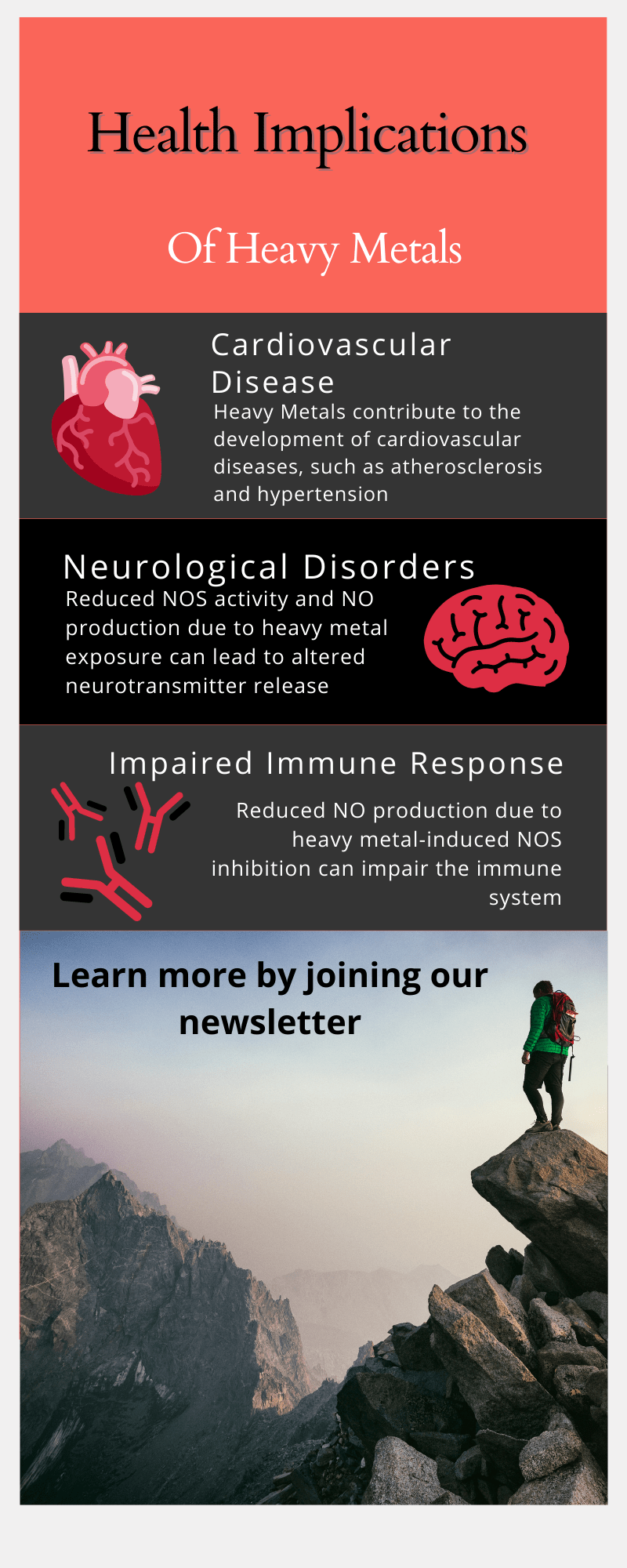
Strategies to Counteract Heavy Metal-Induced NOS Inhibition
A. Chelation Therapy
Chelation therapy involves the administration of chelating agents, such as ethylenediaminetetraacetic acid (EDTA) or dimercaptosuccinic acid (DMSA), which bind to heavy metals and facilitate their excretion from the body. By reducing the body’s burden of heavy metals, chelation therapy can help restore NOS activity and improve overall health (14).
B. Antioxidant Supplementation
Antioxidants, such as vitamins C and E, can help counteract oxidative stress from heavy metals and protect NOS activity (15). Supplementation with antioxidants may help restore NO production and support overall health in individuals exposed to heavy metals.
C. Nutritional and Lifestyle Interventions
Consuming a diet rich in antioxidants, essential nutrients, and anti-inflammatory compounds can help support NOS activity and counteract the effects of heavy metal exposure (16). Additionally, engaging in regular physical activity, maintaining healthy body weight, and avoiding exposure to environmental pollutants can further protect NOS function and overall health.
Conclusion
Heavy metals can negatively impact nitric oxide synthase production through various mechanisms, including inducing oxidative stress, disrupting NOS expression and function, and inhibiting NO bioavailability. The detrimental effects of heavy metals on NOS activity can contribute to the development of cardiovascular diseases, neurological disorders, and impaired immune responses. Chelation therapy, antioxidant supplementation, and nutritional and lifestyle interventions can be employed to counteract these effects. Individuals can proactively protect their health and mitigate the risks associated with heavy metal exposure by understanding the relationship between heavy metals and NOS production.
A Comprehensive Approach to Support NOS Production
This article discusses how can some components contribute to heavy metal detoxification and supports NOS production.
EDTA
Ethylenediaminetetraacetic acid (EDTA) is a well-known chelating agent that binds to heavy metals, such as lead, cadmium, and mercury, facilitating their excretion from the body (17). By removing heavy metals, EDTA can help restore NOS activity and mitigate the negative effects of these metals on nitric oxide (NO) production (18).
Modified Citrus Pectin
Modified citrus pectin is a form of pectin that has been altered to improve its bioavailability and absorption. It has been shown to bind and remove heavy metals from the body, such as lead, mercury, and cadmium (19). Modified citrus pectin can help protect NOS activity and support NO production by aiding in heavy metal detoxification.
Chlorella
Chlorella is a single-celled green alga that has been shown to possess heavy metal-binding properties, particularly for mercury (20). By assisting in removing heavy metals from the body, chlorella can help alleviate the negative effects of these metals on NOS production and support overall health.
Cilantro
Cilantro, also known as coriander, has been shown to have heavy metal-chelating properties, particularly for lead and mercury (21). By aiding in detoxifying heavy metals, cilantro can help protect NOS activity and support NO production.
Shilajit
Shilajit, a natural resinous substance found in the Himalayas, has been reported to have antioxidant and anti-inflammatory properties, which may help counteract heavy metal-induced oxidative stress and inflammation (22). Shilajit can help protect NOS activity and maintain NO production by reducing oxidative stress. Additionally, shilajit has been reported to possess metal-chelating properties, which may further contribute to its heavy metal detoxification effects (23).
Zeolite
Zeolites are natural or synthetic minerals with a unique porous structure, which allows them to bind to and trap heavy metals, such as lead, cadmium, and mercury (24). By assisting in removing heavy metals from the body, zeolites can help protect NOS activity and support NO production.
References:
(1) Valko, M., Morris, H., & Cronin, M. T. (2005). Metals, toxicity and oxidative stress. Current Medicinal Chemistry, 12(10), 1161-1208. https://doi.org/10.2174/0929867053764635
(2) Förstermann, U., & Sessa, W. C. (2012). Nitric oxide synthases: regulation and function. European Heart Journal, 33(7), 829-837. https://doi.org/10.1093/eurheartj/ehr304
(3) Förstermann, U., & Münzel, T. (2006). Endothelial nitric oxide synthase in vascular disease: from marvel to menace. Circulation, 113(13), 1708-1714. https://doi.org/10.1161/CIRCULATIONAHA.105.602532
(4) Brüne, B., Schmidt, K. U., & Ullrich, V. (1990). Activation of soluble guanylate cyclase by carbon monoxide and inhibition by superoxide anion. European Journal of Biochemistry, 192(2), 683-688. https://doi.org/10.1111/j.1432-1033.1990.tb19283.x
(5) Ercal, N., Gurer-Orhan, H., & Aykin-Burns, N. (2001). Toxic metals and oxidative stress part I: mechanisms involved in metal-induced oxidative damage. Current Topics in Medicinal Chemistry, 1(6), 529-539. https://doi.org/10.2174/1568026013394831
(6) Pacher, P., Beckman, J. S., & Liaudet, L. (2007). Nitric oxide and peroxynitrite in health and disease. Physiological Reviews, 87(1), 315-424. https://doi.org/10.1152/physrev.00029.2006
(7) Kielstein, J. T., & Cooke, J. P. (2005). Cardiology and nephrology converge on a common problem: asymmetric dimethylarginine (ADMA), an endogenous inhibitor of nitric oxide synthase, predicts cardiovascular events. Journal of the American Society of Nephrology, 16(9), 2454-2457. https://doi.org/10.1681/ASN.2005060610
(8) Böger, R. H. (2006). Asymmetric dimethylarginine, an endogenous inhibitor of nitric oxide synthase, explains the “L-arginine paradox” and acts as a novel cardiovascular risk factor. Journal of Nutrition, 136(10), 2882S-2887S. https://doi.org/10.1093/jn/136.10.2882S
(9) Vaziri, N. D. (2008). Mechanisms of lead-induced hypertension and cardiovascular disease. American Journal of Physiology-Heart and Circulatory Physiology, 295(2), H454-H465. https://doi.org/10.1152/ajpheart.00158.2008
(10) Navas-Acien, A., Guallar, E., Silbergeld, E. K., & Rothenberg, S. J. (2007). Lead exposure and cardiovascular disease: a systematic review. Environmental Health Perspectives, 115(3), 472-482. https://doi.org/10.1289/ehp.9785
(11) Farina, M., Avila, D. S., da Rocha, J. B., & Aschner, M. (2013). Metals, oxidative stress and neurodegeneration: a focus on iron, manganese and mercury. Neurochemistry International, 62(5), 575-594. https://doi.org/10.1016/j.neuint.2012.12.006
(12) Sanders, T., Liu, Y., Buchner, V., & Tchounwou, P. B. (2009). Neurotoxic effects and biomarkers of lead exposure: a review. Reviews on Environmental Health, 24(1), 15-45. https://doi.org/10.151 5/reveh.2009.24.1.15
(13) Bogdan, C. (2001). Nitric oxide and the immune response. Nature Immunology, 2(10), 907-916. https://doi.org/10.1038/ni1001-907
(14) Flora, S. J., & Pachauri, V. (2010). Chelation in metal intoxication. International Journal of Environmental Research and Public Health, 7(7), 2745-2788. https://doi.org/10.3390/ijerph7072745
(15) Lobo, V., Patil, A., Phatak, A., & Chandra, N. (2010). Free radicals, antioxidants and functional foods: Impact on human health. Pharmacognosy Reviews, 4(8), 118-126. https://doi.org/10.4103/0973-7847.70902
(16) Crinnion, W. J. (2010). The role of nutritional supplements in the treatment of heavy metal toxicity. Alternative Medicine Review, 15(1), 33-47. http://archive.foundationalmedicinereview.com/publications/15/1/33.pdf
(17) Flora, S. J., & Pachauri, V. (2010). Chelation in metal intoxication. International Journal of Environmental Research and Public Health, 7(7), 2745-2788. https://doi.org/10.3390/ijerph7072745
(18) Vaziri, N. D. (2008). Mechanisms of lead-induced hypertension and cardiovascular disease. American Journal of Physiology-Heart and Circulatory Physiology, 295(2), H454-H465. https://doi.org/10.1152/ajpheart.00158.2008
(19) Eliaz, I., Weil, E., & Wilk, B. (2019). Integrative medicine and the role of modified citrus pectin/alginates in heavy metal chelation and detoxification – five case reports. Functional Foods in Health and Disease, 8(12), 430-443. https://doi.org/10.31989/ffhd.v8i12.569
(20) Uchikawa, T., Yasutake, A., Kumamoto, Y., Maruyama, I., Kumamoto, S., & Ando, Y. (2011). The influence of Parachlorella beyerinckii CK-5 on the absorption and excretion of methylmercury (MeHg) in mice. Journal of Toxicological Sciences, 36(1), 121-130. https://doi.org/10.2131/jts.36.121
(21) Aga, M., Iwaki, K., Ueda, Y., Ushio, S., Masaki, N., Fukuda, S., … & Ito, Y. (2001). Preventive effect of Coriandrum sativum (Chinese parsley) on localized lead deposition in ICR mice. Journal of Ethnopharmacology, 77(2-3), 203-208. https://doi.org/10.1016/S0378-8741(01)00289-X
(22) Carrasco-Gallardo, C., Guzmán, L., & Maccioni, R. B. (2012). Shilajit: a natural phytocomplex with potential procognitive activity. International Journal of Alzheimer’s Disease, 2012, 674142. https://doi.org/10.1155/2012/674142
(23) Bhattacharyya, S., & Pal, D. (2013). In vitro study of the effects of Shilajit on the activities of Ehrlich ascites tumor cells. Pharmaceutical Biology, 51(2), 269-272. https://doi.org/10.3109/13880209.2012.727360
(24) Selvam, T., Schwieger, W., & Dathe, W. (2017). The potential of natural and modified zeolites for heavy metal capture in contaminated waters. In Natural Mineral Nanotubes (pp. 363-380). CRC Press. https://doi.org/10.1201/b18522-16

